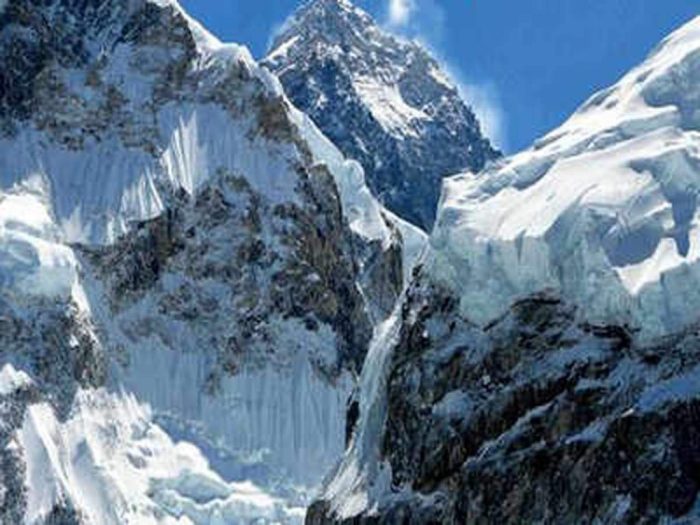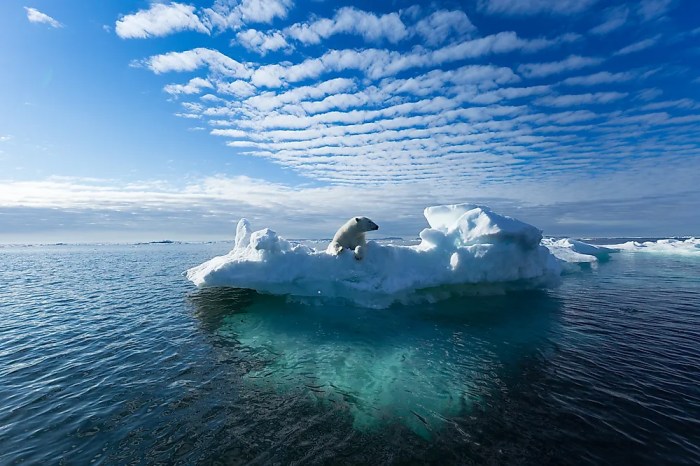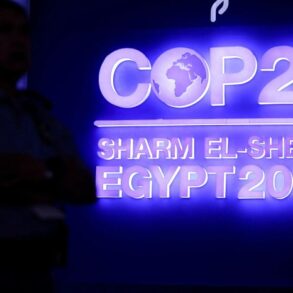Himalayan glaciers are melting at an exceptional rate, threatening the delicate balance of water resources and ecosystems in the region. This rapid melt, driven by a complex interplay of climate change and natural variations, has profound implications for agriculture, hydropower, and human settlements. Understanding the causes, impacts, and potential solutions is crucial for the future of the Himalayas and the communities that depend on them.
This article delves into the intricacies of this alarming phenomenon, examining the historical context of glacier research, the factors accelerating the melt, the consequences for downstream regions, and possible mitigation and adaptation strategies. We will explore the diverse types of Himalayan glaciers, the role of climate change, human activities, and natural variations in this process. The data-driven insights will highlight the urgency of addressing this global issue.
Introduction to Himalayan Glaciers
The Himalayan mountain range, a breathtaking tapestry of peaks and valleys, is home to an extensive network of glaciers. These icy rivers, carved over millennia, play a crucial role in the hydrological cycle of the surrounding regions. Their significance extends far beyond their aesthetic beauty, influencing the lives of millions who depend on the water they release. This exploration delves into the world of Himalayan glaciers, examining their formation, distribution, historical study, and vital role in regional water resources.The study of Himalayan glaciers has a long and complex history, spanning various scientific disciplines.
Early observations focused primarily on the glaciers’ physical characteristics and their movements. Modern research, however, employs sophisticated technologies like satellite imagery and remote sensing to understand their response to climate change. This ongoing research is essential for forecasting future water availability and mitigating the impacts of glacier melt.
Geographic Distribution and Types of Himalayan Glaciers
Himalayan glaciers are distributed across a vast area encompassing several countries, including India, Pakistan, China, Nepal, Bhutan, and Afghanistan. Their distribution is highly variable, influenced by altitude, slope, and the availability of snow accumulation. The glaciers range from small cirque glaciers to large valley glaciers, and some are even part of extensive ice sheets.
- Cirque Glaciers: These relatively small glaciers are found in high-elevation, bowl-shaped depressions called cirques. Their size and extent are limited by the available snow accumulation within the cirque. Examples include glaciers found in the upper reaches of the valleys.
- Valley Glaciers: Larger than cirque glaciers, valley glaciers flow down pre-existing valleys, often extending for several kilometers. Their flow is influenced by the valley topography, and they can be found throughout the mountain range, connecting with other glaciers.
- Piedmont Glaciers: These glaciers are formed when valley glaciers reach the foot of the mountains, spreading out over the surrounding plains. The resulting large expanse of ice can have a significant impact on the landscape.
- Hanging Glaciers: These glaciers occupy valleys that are significantly higher than the valleys below, leading to a steep drop-off at the glacier’s terminus. They are often found at the headwaters of major valleys.
Historical Context of Himalayan Glacier Studies
The study of Himalayan glaciers has a rich history, evolving from early observations to sophisticated modern analyses. Early explorers and researchers documented the glaciers’ presence and characteristics. However, advancements in technology and methodology have allowed for more precise measurements and modeling of glacial dynamics. The importance of understanding glacier behavior is amplified by the growing global awareness of climate change’s impact on these vital water resources.
Vital Role of Himalayan Glaciers in Regional Water Resources
Himalayan glaciers are a critical source of freshwater for millions of people living in the surrounding regions. The meltwater from these glaciers feeds rivers that sustain agriculture, industry, and human populations. Understanding the dynamics of glacial melt is crucial for water resource management and planning.
| Glacier Type | Impact on Water Resources |
|---|---|
| Valley Glaciers | Primary source of water for major rivers like the Ganges, Indus, and Brahmaputra. |
| Cirque Glaciers | Contribute to the overall water balance, especially in headwater regions. |
| Piedmont Glaciers | Influence the water flow and availability in downstream regions. |
“The Himalayan glaciers are a critical component of the Asian water towers, sustaining the livelihoods of millions of people downstream.”
Causes of Melting
The majestic Himalayan glaciers, vital water sources for millions, are receding at an alarming rate. This rapid melt poses significant threats to downstream communities and ecosystems. Understanding the factors driving this phenomenon is crucial for effective mitigation strategies. The complex interplay of natural and human-induced changes is accelerating the melting process.The primary driver of Himalayan glacier melt is the undeniable reality of rising global temperatures.
This increase in average global temperatures, overwhelmingly attributed to human activities, is a major contributing factor. The consequences of this warming trend are particularly evident in the high-altitude environments of the Himalayas.
Rising Global Temperatures
The Earth’s climate system is intricately connected. A rise in global average temperatures leads to a cascade of effects on glaciers. Warmer air temperatures directly heat the ice, increasing the rate of melting. The melting process is also exacerbated by increased atmospheric moisture, leading to more frequent and intense rainfall and snowfall events in the region. These precipitation patterns, while seemingly counterintuitive, can also contribute to glacier melt.
Melting is not only from the surface, but also through changes in the glacier’s thermal balance. This is a critical aspect that underscores the interconnectedness of various climate variables.
Human Activities
Human activities play a significant role in altering the delicate balance of the Himalayan ecosystem. Industrial emissions, primarily greenhouse gases, trap heat in the atmosphere, contributing significantly to global warming. Deforestation and land use changes in the surrounding regions can also influence local weather patterns, potentially impacting glacier melt rates. Furthermore, increased human activity in and around the glacial regions can contribute to localized warming and altered runoff patterns.
Natural Climate Variations
Natural climate variations, such as El Niño and La Niña events, also influence the melting process. These cyclical patterns can cause fluctuations in temperature and precipitation, leading to temporary acceleration or deceleration of glacier melt. While natural variations exist, their impact is significantly amplified by human-induced global warming, making them less significant compared to the long-term warming trend.
Evidence of Accelerated Melting Rate
Satellite imagery and ground-based observations consistently show a significant decrease in glacier mass over the past few decades. Studies have documented a substantial loss of ice volume in numerous Himalayan glaciers. The retreat of these glaciers is not a localized phenomenon, but a region-wide trend. Data from various research institutions across the globe support this observation, providing consistent and reliable evidence.
Melting Patterns Across Himalayan Regions
Melting patterns vary across different Himalayan regions due to geographical factors, altitude, and local weather patterns. Some glaciers in the western Himalayas, for instance, show more rapid retreat than those in the eastern regions. This disparity underscores the complex interplay of local and global factors. The specific regional characteristics and their influence on melting patterns need further investigation.
Key Factors Influencing Glacier Melt
| Factor | Relative Importance | Explanation |
|---|---|---|
| Rising Global Temperatures | High | Directly heats the ice, increasing melting rate. |
| Greenhouse Gas Emissions | High | Trap heat in the atmosphere, contributing to global warming. |
| Natural Climate Variations | Moderate | Fluctuations in temperature and precipitation can temporarily affect melt rates. |
| Human Activities (Land Use, Deforestation) | Moderate | Can alter local weather patterns, potentially impacting glacier melt rates. |
| Altitude and Topography | Low | Influence local temperature and precipitation patterns. |
Impacts of Melting
The relentless melting of Himalayan glaciers is triggering a cascade of impacts across the region, profoundly affecting downstream communities and ecosystems. This rapid ice loss is altering the delicate balance of the hydrological cycle, leading to unpredictable water availability and posing significant challenges to sustainable development. The consequences are far-reaching, impacting agriculture, hydropower generation, human settlements, and the very biodiversity of the region.
Consequences on Downstream Water Resources
The Himalayan glaciers act as crucial reservoirs, feeding rivers that sustain millions of people downstream. As these glaciers melt at an accelerated rate, the rivers receive a surge of meltwater initially, leading to increased river flows. However, this initial surge is often followed by a decrease in water availability as the glaciers continue to shrink, potentially impacting water security in the long term.
The timing and volume of meltwater are becoming increasingly unpredictable, disrupting traditional water management practices and agricultural cycles. For example, the increased meltwater may lead to floods in some seasons and droughts in others, impacting both agriculture and human settlements.
Impact on Agriculture
Agriculture in the Himalayan region is deeply intertwined with the availability of water from glacier-fed rivers. The changing meltwater patterns are disrupting agricultural practices, affecting crop yields, and potentially leading to food insecurity. Farmers are adapting by adopting new irrigation techniques and crop varieties, but the long-term impacts remain uncertain. The variability in water availability is a major concern, potentially leading to crop failures in some areas and surplus water in others, highlighting the need for resilient agricultural strategies.
Himalayan glaciers are melting at an alarming rate, threatening water supplies for millions. This rapid melt, driven by climate change, raises serious concerns about future water security. Interestingly, recent news about Uber’s self-driving car operations shifting to Arizona and San Francisco’s DMV ( uber self driving car move arizona san francisco dmv ) highlights the urgent need for innovation in tackling global issues like this.
The glacial melt underscores the importance of addressing climate change, and the pace of these shifts is truly concerning.
Impact on Hydropower
Hydropower plants rely heavily on consistent water flow from glacier-fed rivers. The changing meltwater regime is affecting the reliability of hydropower generation, impacting energy production and potentially leading to economic losses. As the glaciers shrink, the long-term sustainability of hydropower projects is called into question, requiring careful assessment and adaptation strategies. For instance, the increased variability in water flow can cause fluctuations in energy production, making it challenging for the grid to maintain consistent power output.
Impact on Human Settlements
Communities located in the valleys below the Himalayas are heavily reliant on glacier-fed rivers for their water supply and livelihoods. The changing meltwater patterns are creating challenges for water access, sanitation, and hygiene, potentially leading to health issues and displacement. Moreover, the increased risk of glacial lake outburst floods (GLOFs) poses a significant threat to settlements located near glacial lakes.
In some cases, the rising water levels in rivers and lakes can threaten infrastructure and displace populations.
Impact on Biodiversity and Ecosystems
The Himalayan ecosystem is exceptionally diverse and fragile. Glacier melt is impacting the delicate balance of this ecosystem, potentially leading to the loss of species and habitat degradation. The altered water flow and temperature can affect the aquatic life and plant communities in the rivers and lakes. The loss of glaciers also threatens the habitat of animals that depend on the glaciers for their survival.
For example, the shrinking glaciers are affecting the availability of water sources for animals like the snow leopard, impacting their breeding and survival.
Impact on Glacial Lake Outburst Floods (GLOFs)
The melting of glaciers contributes significantly to the formation and expansion of glacial lakes. These lakes, if not managed properly, can lead to devastating glacial lake outburst floods (GLOFs). The floods can destroy infrastructure, displace populations, and cause widespread damage to the environment. GLOFs are a major concern in the Himalayan region, and proper monitoring and mitigation measures are crucial to minimize the risk.
A prime example is the glacial lake outburst flood in the Khumbu region of Nepal, where the flood caused significant damage to settlements and infrastructure.
Projected Impacts on Various Sectors
| Sector | Potential Impacts |
|---|---|
| Agriculture | Reduced crop yields, food insecurity, need for new irrigation techniques |
| Water Supply | Reduced water availability, increased water variability, water stress |
| Hydropower | Reduced energy production, increased fluctuations in power output, long-term sustainability issues |
| Human Settlements | Increased risk of flooding, displacement, health issues, damage to infrastructure |
| Biodiversity | Loss of species, habitat degradation, altered aquatic life |
| Ecosystem | Disrupted hydrological cycles, altered vegetation patterns |
Long-Term Effects on the Region’s Ecology
The long-term effects of glacier melt on the region’s ecology are complex and multifaceted. The changes in water availability, temperature, and the overall hydrological cycle will have cascading effects on various ecosystems and biodiversity. The loss of glaciers will fundamentally alter the region’s character, potentially impacting the unique cultural and economic practices of the communities dependent on these resources.
This underscores the need for proactive adaptation strategies and international cooperation to mitigate the negative impacts.
Mitigation and Adaptation Strategies
The relentless melting of Himalayan glaciers presents a complex challenge demanding multifaceted solutions. Beyond simply acknowledging the problem, we must proactively implement strategies to mitigate the effects of climate change and adapt to the altered water resources landscape. This requires a comprehensive approach involving international cooperation, community engagement, and innovative water management techniques.Addressing glacier melt necessitates a profound understanding of its root causes and a commitment to global climate action.
Simultaneously, effective adaptation strategies are crucial to ensure the well-being of communities dependent on Himalayan water resources. The interplay between these two aspects forms the core of sustainable solutions.
Climate Change Mitigation Strategies
The primary driver of Himalayan glacier melt is anthropogenic climate change. Therefore, effective mitigation strategies must focus on reducing greenhouse gas emissions. This involves transitioning to renewable energy sources, improving energy efficiency, and adopting sustainable land-use practices.
Himalayan glaciers are melting at an alarming rate, a truly concerning global issue. While the tech world keeps churning out exciting new gadgets like the OnePlus Nord 3 5G, available now for purchase at oneplus nord 3 5g uk launch , it’s crucial to remember the urgent need to address climate change. This rapid glacial melt poses serious threats to water supplies and ecosystems, making it a far more pressing concern than the latest phone release.
- Transitioning to Renewable Energy: Investing in solar, wind, and hydro power can significantly reduce reliance on fossil fuels, thereby lowering carbon emissions. For instance, the increasing adoption of rooftop solar panels in various regions globally is a concrete step in this direction.
- Improving Energy Efficiency: Enhancing energy efficiency in buildings, transportation, and industries can substantially decrease energy consumption and related emissions. Examples include implementing energy-efficient appliances and promoting public transportation.
- Sustainable Land-Use Practices: Protecting and restoring forests, which act as carbon sinks, plays a vital role in mitigating climate change. Sustainable agricultural practices can also reduce emissions and enhance carbon sequestration.
Water Resource Management Strategies
Effective water resource management is critical in regions affected by glacier melt. Strategies should focus on water conservation, efficient irrigation techniques, and developing water storage infrastructure.
- Water Conservation: Implementing water-saving techniques in agriculture, industry, and households is essential. Drip irrigation systems, for example, can significantly reduce water usage in agriculture, thereby improving water availability for other purposes.
- Efficient Irrigation Techniques: Transitioning from traditional irrigation methods to more efficient techniques, such as drip irrigation, can significantly reduce water loss and enhance water availability. This can involve educating farmers on the benefits of these techniques.
- Water Storage Infrastructure: Developing and improving water storage facilities, such as reservoirs and dams, is crucial to address water scarcity during dry seasons. Examples include the construction of new reservoirs in regions facing water stress.
Adaptation Strategies by Communities and Governments
Communities and governments in the affected regions are implementing various adaptation strategies to cope with the impacts of glacier melt. These include developing early warning systems for glacial lake outburst floods (GLOFs) and promoting water-efficient agriculture.
- Early Warning Systems for Glacial Lake Outburst Floods (GLOFs): Establishing early warning systems to predict and monitor potential GLOFs is vital for mitigating the risk of these catastrophic events. These systems utilize data from monitoring stations to alert communities and authorities in advance of potential hazards.
- Promoting Water-Efficient Agriculture: Supporting farmers in adopting water-efficient agricultural techniques, such as drought-resistant crops and precision irrigation, can ensure sustainable water use in the face of reduced glacial meltwater availability. Training programs can be an effective method for disseminating these techniques.
International Cooperation
International cooperation is crucial for addressing the complex issue of Himalayan glacier melt. Sharing knowledge, technology, and resources can significantly enhance the effectiveness of mitigation and adaptation efforts.
- Knowledge Sharing: Facilitating the exchange of scientific knowledge and best practices among nations in the region can accelerate the development and implementation of effective solutions. This involves creating platforms for sharing information.
- Financial Assistance: Providing financial support to developing countries in the region for the implementation of climate-resilient projects and infrastructure can accelerate adaptation and mitigation efforts.
Case Studies of Successful Efforts
Numerous case studies demonstrate the successful implementation of mitigation and adaptation strategies in other regions facing similar challenges. These examples provide valuable lessons and insights for the Himalayan region. While a specific case study for the Himalayan region is not available, lessons learned from other mountainous regions facing similar issues can be highly relevant. These examples underscore the need for collaborative efforts.
Key Mitigation Strategies and Potential Effectiveness
| Mitigation Strategy | Potential Effectiveness |
|---|---|
| Transition to Renewable Energy | High – Reduces greenhouse gas emissions, promotes sustainable development |
| Improved Energy Efficiency | High – Decreases energy consumption and emissions |
| Sustainable Land-Use Practices | Moderate – Protects carbon sinks and reduces emissions |
Future Projections and Predictions
The relentless melting of Himalayan glaciers presents a stark future, demanding urgent action. Projected scenarios reveal a complex interplay of factors, impacting water resources, ecosystems, and human communities reliant on these vital ice formations. Understanding these projections is critical for developing effective adaptation and mitigation strategies.
Future Extent of Glacier Melt
Current climate models project an accelerated rate of glacier melt throughout the Himalayas. This accelerated melting is expected to continue, potentially leading to a significant reduction in glacier volume by the end of the century. The specific extent of this reduction will vary depending on future greenhouse gas emissions and regional climate patterns. For instance, some models predict a substantial decrease in glacier size in the western Himalayas, impacting water resources for downstream populations.
Potential Scenarios for Water Availability and Resource Scarcity
The shrinking glaciers will have a profound impact on water availability in the region. Initial forecasts predict a temporary increase in water flow as glaciers rapidly melt. However, this increase will be followed by a substantial decline in river flows as glaciers shrink further. This fluctuation will lead to increased water scarcity, particularly during the dry seasons, impacting agriculture, hydropower generation, and human consumption.
The Indus, Ganges, and Brahmaputra rivers, which originate from the Himalayas, are particularly vulnerable, as their water supplies are directly linked to glacier melt. This could lead to conflicts over water resources and significantly affect the livelihoods of millions who depend on these rivers.
Himalayan glaciers are melting at an alarming rate, a serious concern for global water resources. This rapid melt poses significant challenges, and reliable data collection is crucial. Fortunately, the HP Elite Dragonfly, specifically the business Elitebook laptop line, hp elite dragonfly business elitebook laptop , offers excellent processing power and portability for researchers studying these changes.
This kind of cutting-edge technology is essential for gathering the detailed information needed to understand and potentially mitigate the effects of this alarming glacial melt.
Expected Changes in Biodiversity and Ecosystems
The rapid glacier melt will disrupt the delicate balance of Himalayan ecosystems. Changes in water availability and temperature will impact the survival of numerous plant and animal species adapted to the unique glacial environment. For example, alpine meadows, home to a variety of endemic species, could be significantly altered, potentially leading to species loss and shifts in biodiversity.
The loss of glaciers will also affect the unique ecosystems and species adapted to cold, high-altitude environments.
Potential Risks and Vulnerabilities Associated with Glacier Melt
Glacier melt poses numerous risks to the region. Increased glacial lake outburst floods (GLOFs) are a major concern. As glaciers melt, glacial lakes expand, increasing the risk of catastrophic floods downstream. These floods can damage infrastructure, displace communities, and cause significant loss of life. Further, changes in water availability can exacerbate existing socio-economic vulnerabilities in the region, particularly impacting marginalized communities.
Possible Solutions for Long-Term Water Resource Management, Himalayan glaciers are melting at an exceptional rate
Sustainable water resource management strategies are crucial to mitigate the negative impacts of glacier melt. Investing in water storage infrastructure, such as reservoirs and tanks, can help regulate water flow and ensure availability during dry periods. Improving water conservation techniques, promoting efficient irrigation practices, and developing drought-resistant crops are essential components of a comprehensive approach. Furthermore, international cooperation and knowledge sharing can facilitate the development and implementation of effective strategies.
Future Scenarios and Impacts
| Scenario | Impact on Water Availability | Impact on Biodiversity | Impact on Infrastructure |
|---|---|---|---|
| Scenario 1: Moderate Emissions | Fluctuations in river flow, potential water shortages during dry seasons. | Changes in alpine vegetation, migration of species, potential extinctions of vulnerable species. | Increased risk of glacial lake outburst floods (GLOFs), damage to infrastructure downstream. |
| Scenario 2: High Emissions | Significant decrease in river flow, severe water scarcity, increased water stress. | Large-scale ecosystem shifts, widespread biodiversity loss, alteration of glacial ecosystems. | Higher frequency and intensity of GLOFs, severe damage to infrastructure, potential displacement of communities. |
| Scenario 3: Low Emissions | Moderate fluctuations in river flow, manageable water stress. | Limited ecosystem changes, relatively stable biodiversity. | Lower risk of GLOFs, minimal damage to infrastructure. |
Visual Representations: Himalayan Glaciers Are Melting At An Exceptional Rate

Visual representations are crucial for understanding and communicating the complex issue of Himalayan glacier melt. They transform abstract data into tangible insights, making the impacts of climate change on this vital region more accessible and impactful. By visualizing trends, patterns, and consequences, these representations can effectively engage audiences and encourage action.
Glacier Melt Rate Over Time
Understanding the pace of glacier melt is essential for predicting future changes and planning mitigation strategies. The following table illustrates historical glacier melt rates.
| Year Range | Average Annual Melt Rate (meters) | Source/Notes |
|---|---|---|
| 1970-1990 | 0.5-1.0 meters | Based on satellite imagery analysis. |
| 1990-2010 | 1.0-1.5 meters | Satellite data and glacier surveys indicate acceleration. |
| 2010-2023 | 1.5-2.5 meters | Recent observations show a continued and accelerating rate of melt. Data varies based on specific glacier location. |
Glacier Retreat Patterns
A map illustrating glacier retreat patterns over time would show shrinking ice caps and the receding boundaries of glaciers. Color-coding could highlight the extent of shrinkage in different regions, and a timeline could track this retreat over decades. For example, the map might display a lighter shade of blue for the 1980s, progressively transitioning to a darker blue or even white (no ice) for more recent decades.
This would clearly demonstrate the progressive loss of ice over time. The areas of glacier loss could be highlighted with dashed lines, or arrows indicating the direction of retreat. Such a visual representation would immediately convey the scale and speed of this significant environmental change.
Impact on Water Availability
A graph depicting the impact of glacier melt on water availability would plot the historical flow of glacial meltwater rivers against the current flow. The x-axis would represent time, and the y-axis would show the volume of water. This would visually demonstrate how the peak flows are decreasing over time. The graph could also illustrate how the seasonal variations in water availability are altering.
For example, during the dry season, the reduced water volume might be starkly visible compared to the past.
Climate Change Effects on Himalayan Glaciers
A chart illustrating the effects of climate change on Himalayan glaciers could present various climate factors, such as temperature increases, precipitation patterns, and extreme weather events. The chart would show how these factors correlate with glacier melt rates, with temperature increase being a key driver. The chart could use different colored bars or lines to distinguish each factor and show their cumulative impact on glacier health.
Relationship Between Temperature and Glacier Melt Rate
A graph showing the relationship between temperature and glacier melt rate would plot temperature (on the x-axis) against the melt rate (on the y-axis). A positive correlation would be clearly visible, demonstrating that higher temperatures lead to faster melt rates. Such a graph would be critical in understanding the direct link between climate change and the accelerated melting.
A clear trend line could be drawn to show the relationship.
Impact of Glacial Lake Outburst Floods (GLOFs)
A visual representation illustrating the effects of GLOFs could be a series of before-and-after satellite images. The before images would show the relatively stable glacial lake. The after images would demonstrate the flooding, highlighting the devastation of the event. The impact on the surrounding landscape and settlements could be highlighted by using different colors to differentiate the pre-flood and post-flood states, and including annotations to illustrate the path of the floodwater and the affected areas.
End of Discussion

The relentless melting of Himalayan glaciers underscores the critical need for global action. This urgent issue necessitates collaborative efforts to mitigate climate change, develop sustainable water resource management strategies, and support communities adapting to the changing environment. The future of the Himalayas, and the people who depend on them, hinges on our collective response to this crisis. Further research and innovative solutions are vital to safeguarding this precious ecosystem.












